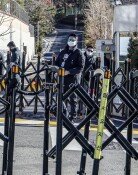Daring rescue expected to end ransom for hostage release
Daring rescue expected to end ransom for hostage release
Posted January. 22, 2011 11:48,
A South Korean government official said Friday, We expected that the governments decision to launch a rescue operation despite risks would entail public controversy. But we judged that only decisive and stern action against Somali pirates will prevent them from hijacking (South) Korean vessels in the future.
Referring to the rescue of the Samho Jewelry crew by the destroyer Choi Young, the official said, We judged that it is problematic for a military vessel deployed there to control pirates not to take action even when a (South) Korean vessel was hijacked.
The operation also reflects South Koreas rejection of paying large ransoms to pirates, which Seoul did when the Samho Dream was hijacked in April last year.
After the hijacking of the Samho Jewelry, the government planned a military operation but feared casualties of hostages and troops in the operation, anxiety among neighboring countries, and pollution caused by damage to vessels. Seoul, however, concluded that Korea should no longer be recognized as a country that pays huge ransoms to pirates, that the Cheonghae Unit should dispel the sense of hopelessness; and that a decisive operation would send a stronger message to pirates.
Before the Samho Jewelrys hijacking, seven South Korean vessels were taken by Somali pirates but none of them were freed through military action. In contrast, France rescued all hostages through military operations between April 2008 and April 2009, when four French vessels were hijacked by Somali pirates.
Since then, Somali pirates have reportedly not hijacked a French vessel.
The need for the South Korean military to recover its low self-confidence provided another reason for a military operation. While discussing resolving the Samho Jewelry hijacking, the majority of military insiders reportedly said the armed forces received criticism for their passive response after North Koreas sinking of the naval vessel Cheonan and shelling of Yeonpyeong Island last year, and that the military cannot afford to be dominated by pirates.
A military official said, Had an operation of this nature failed and casualties occurred, the military would have come under immense public criticism, and thus it was very difficult to launch the operation, adding, In an environment where the public trusts the military, we can conduct operations courageously even if we fail.
Led by the Foreign Affairs and Trade Ministry, the South Korean government also supported the rescue. The ministry established a headquarters for the Samho Jewelry hijacking in Seoul and another for onsite countermeasures at the South Korean Embassy in Kenya.
The ministry discussed responses with other government ministries including the Land, Transport and Maritime Affairs Ministry and the Defense Ministry.
The Foreign Ministry also formed Wednesday a contingency response team lead by Baek Ju-hyeon, chief of the overseas Koreans and consular affairs bureau, and Kang Seok-hee, chief of the Overseas Korean Nationals Protection and Crisis Management Division, and dispatched them to Oman. The team is assisting medical treatment of the three soldiers and the vessels captain who were injured in the rescue operation.
The ministry also consulted with Indonesia and Myanmar, whose nationals were members of the Samho Jewelry crew, and asked allies including the U.S. for cooperation.
zeitung@donga.com will71@donga.com







